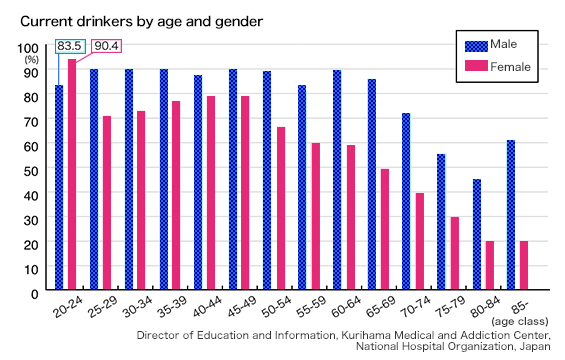Risks that vary depending on gender
Women are more susceptible to the effects of alcohol than men, both mentally and physically.
This is because the rate at which alcohol is broken down in women is slower than in men, and the alcohol in their blood tends to become more concentrated.
For this reason, high concentrations of alcohol tend to remain in the body, making women more susceptible to liver disease and alcoholism. Furthermore, it is said that if women drink large amounts of alcohol, they are at a higher risk of developing breast cancer and osteoporosis.
Also, women experience various changes throughout their life stages.
In particular, drinking alcohol while pregnant is a big no-no. This is because the alcohol consumed while pregnant is transported directly to the fetus through the placenta. Drinking alcohol while pregnant can also cause FAS (Fetal Alcohol Syndrome), so if you are pregnant, please do not drink alcohol.
Not only while pregnant, but also while breastfeeding, alcohol can have an adverse effect on the baby through breast milk, so please refrain from drinking alcohol for the sake of the baby's health.
Women and alcohol these days
In recent years, the way women drink alcohol has changed. This is not only because of changes in their working condition, but also because of the increase in the number of women's parties and the variety of gentle alcohol.
In 2008, a nationwide survey of current drinkers by age and gender was conducted, and the rate of female drinkers in their early 20s exceeded that of male drinkers. In addition, the number of women who drink alcohol at least three times a week has increased from 6.3% in1989 to 7.7% in2011, while the trend among men has decreased.
However, there are also negative effects due to the increase in situations where women can enjoy alcohol casually.
The number of women suffering from alcoholism has been increasing in recent years, and it is estimated that they now account for around 20% of total alcoholic patients. It has also been found that women develop alcoholism in a shorter period of time than men, and that the peak age for patients is in their 30s, which is younger than for men.

Are women more vulnerable to alcohol?
Women are indeed more vulnerable to alcohol. This is due to the physical characteristics of women, and even if they drink the same amount of alcohol at the same time as men, women are impacted differently.
Firstly, women's bodies and livers are smaller than men's, and the speed at which they break down alcohol is slower, so the average amount of alcohol that can be broken down in an hour is 4 grams for women, compared to the average of 5 grams for men. For example, a man will take 4 hours to metabolize a tall can of beer (500ml), but a woman will take 5 hours. (The speed at which alcohol is broken down is just a rough guide, and there are individual differences.)
Secondly, women have more body fat and less body water, so the alcohol concentration in their blood tends to be higher.
For this reason, high concentrations of alcohol tend to stay longer for women, thus they get drunk more easily and put a greater strain on their livers. It has been reported that women who drink too much alcohol can develop cirrhosis of the liver up to eight years earlier than men, and that the average age of onset of alcoholism is 20 years younger in women than in men, so it is important to be aware of the impacts.
Let's learn about the unique physical characteristics of women and manage a good relationship with alcohol.

Effects on Women's Unique Diseases
While it is good to enjoy alcohol in moderation, women's bodies are very delicate. Drinking too much or developing an unhealthy drinking habit can lead to women-specific illnesses.
One such illness is breast cancer.
For example, a report says that if the amount of alcohol consumed per day increases by 10 grams of alcohol, the risk of developing breast cancer increases by 7.1%. In particular, if there are close relatives with breast cancer, the risk of developing the illness also increases.
Furthermore, heavy drinking is a factor that reduces bone density, and since bone density decreases rapidly around the time of menopause, which occurs around the age of 50, there are reports that osteoporosis is more likely to occur when menopause coincides with this time. Menopause is a time of change for both the body and mind. While being conscious of your health, let's change the way we enjoy alcohol.
How women can enjoy alcohol
Women are more sensitive to alcohol than men, but that doesn't mean women can't enjoy it as much as men.
Many women like to chat while eating. If you bring a dish to share and enjoy the marriage of food and alcohol in a lively atmosphere, you should be able to enjoy yourself without drinking too much. Drinking alcohol while eating is also good for your health, so it's a win-win situation. These days, sweets that go well with alcohol are also popular, so women can also have a lively dessert time.
Also, if you dilute strong alcohol with fruit juice or soda, the alcohol content will decrease and the taste and appearance will become more suited to women. Whether from a restaurant or a store, there are more and more low-alcohol drinks available, so if you make good use of them, you can expand how women enjoy alcohol even further.

Drinking alcohol while pregnant is dangerous for the fetus, so you must not drink alcohol
Pregnant women should not drink alcohol.
The alcohol you consume is transported directly to the baby through the placenta, so the baby is also drinking alcohol.
In some cases, those babies develop Fetal Alcohol Syndrome (FAS), which can cause developmental disorders, intellectual disabilities, facial abnormalities, ADHD (Attention Deficit Hyperactivity Disorder), and other problems. These disorders can remain even into adulthood.
A baby in the womb is also a “person under 20 years of age”.
Let's stop drinking alcohol for the sake of the baby that is to be born.

Let's all support mothers and their babies
Pregnancy is an important period for nurturing life.
During pregnancy, women prepare both mentally and physically to become mothers, together with the baby growing inside them.
For the baby’s sake, mothers often have to give up the things they like to do, and sometimes they may feel frustrated or sad.
Even the alcohol they used to enjoy is put on hold during this period.
Family members, friends, and other people close to the mother should support her and her baby by creating an environment free from alcohol as much as possible, and by not drinking or encouraging others to drink alcohol in their presence.

Don't drink alcohol during breastfeeding, either
Just because you've given birth doesn't mean you can drink alcohol.
Don't drink alcohol during breastfeeding, either.
The alcohol that the mother drinks is passed on to the baby through breast milk, so the baby is drinking alcohol. The rate at which alcohol is transferred to breast milk is high, and it is said that the alcohol concentration in the blood is almost the same as that in breast milk, so there is a risk of adverse effects on the baby.

Stop drinking alcohol from the time you become aware that you are pregnant
“Now may be the time to have a baby...”
If you start thinking like this, then you should also stop drinking alcohol.
Even before you become pregnant, there are cases where you may be drinking alcohol without realizing that you are pregnant. If you recognize this, you should definitely stop.
Giving up alcohol is the first step towards becoming a mother. Please ask for the cooperation of everyone around you, including family, friends and colleagues.
Source
-
Brewers Association of Japan, Japan Spirits and Liqueurs Makers Association “Recommendations for Moderate Drinking”
-
HEALTH AND MEDICINE OF ALCOHOL ASSOCIATION ”Women and Drinking”